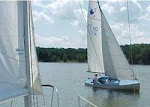A sailmaker can design the aerodynamic shape of our mainsail for one wind speed only! As the wind force changes, the sail's shape will also change because of sail cloth stretch. As the wind gets stronger the draft gets fuller and the wind pressure moves the draft aft. Conversley, as the wind force decreases, the draft moves forward and the sail flattens. Thus we must use draft controls to keep the right amount of draft in the right location. These controls can increase a sail's effective range to 3 or 4 knots above the sail's designed velocity. So a medium to light sail might be designed for 8 knots but could have a range of between 4 and 12 knots using draft control techniques. The sails we use at Wildwood basically cover our range of sailing wind speed fairly well.
Draft is the source of the driving power of the boat. The more draft you have, the more power in the sail. This is within practical limits- until the sail luffs, or in heavy weather when the boat is overpowered. In light air you want to get as much driving power as possible, so get as much draft as you can while still keeping a good pointing angle.
MAINSAIL DRAFT CONTROL
LUFF TENSION controls the fore and aft location of the draft. Change tension by moving the boom up or down on its sliding gooseneck by altering halyard tension or by using a cunningham. IF the draft in the mainsail has been forced aft by increased wind, it can be moved forward again by increased luff tension. It can, of course, be moved aft by easing luff tension.
FOOT TENSION controls the amount of draft in the lower half of the sail. Create more draft by easing foot tension, less draft by tightening foot tension. Do this by using the clew outhaul.
LEACH TENSION- Most overlooked factor in draft control. A loose leach removes curvature from the after portion of the sail rendering it relatively ineffective. A loose leach causes the deepest part of the remaining draft to move forward. A tight leach curves the leach to windward thus increasing draft in the aft portion of the sail and moving the deepest point of draft aft. We control leach tension with the mainsheet. As we ease the sheet, the leach falls off to windward more and more. This fall off or twist is at its greatest point about 3/4 of the way up the leach. A certain amount of twist is needed. The sail sections aloft should be pointed about 5degrees closer to the wind. If you have the right amount of twist and if the foot and luff tensions are right the ENTIRE LEADING EDGE OF THE SAIL WILL LUFF SIMULTANEOUSLY.
I strongly recommend the use of 2 or 3 tell tales on the mainsail. Fasten them at t
 he leach at each batten. They will indicate when your mainsail is properly trimmed and when it is stalled. If they flow steadily aft, trim is good. If they fall or flutter forward, the after end of the sail is stalled.
he leach at each batten. They will indicate when your mainsail is properly trimmed and when it is stalled. If they flow steadily aft, trim is good. If they fall or flutter forward, the after end of the sail is stalled.GOOD TRIM -Tell tales fly aft

SAIL STALLED
Trimmed in too far,
vang too tight or
sheets too tight.
Loosen sheets.
MAINSAIL FULLNESS WITH BOAT AT REST
Curves show shape of mainsail at rest without full action of wind blowing into them.
[a] LIGHT AIRS

There should be almost no tension on the luff at all. The wind isn't strong enough to alter the sails shape; so start off properly shaped.
[b] MEDIUM WINDS
Hoist mainsail hard enough to draw the flow forward into a fold up the luff. It will blow back as you start sailing.
[c] HEAVY WINDS
Here you need the greatest possible tension on the luff, otherwise, the strong wind will blow the camber aft to an inefficient position.

HOW FULL? MAINSAIL SHAPES
Note how the powerpoint moves forward as the sail is flattened.

No comments:
Post a Comment